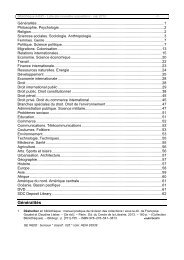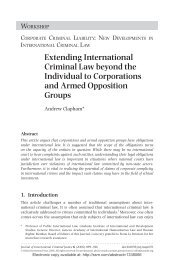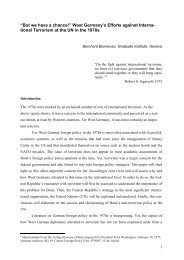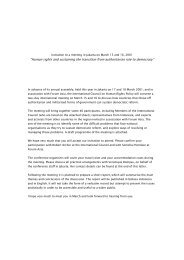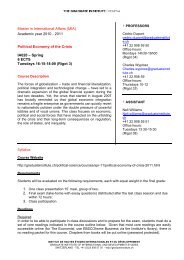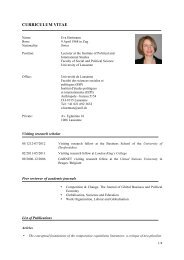The 1953 Coup D'etat in Iran Author(s): Mark J. Gasiorowski Source ...
The 1953 Coup D'etat in Iran Author(s): Mark J. Gasiorowski Source ...
The 1953 Coup D'etat in Iran Author(s): Mark J. Gasiorowski Source ...
You also want an ePaper? Increase the reach of your titles
YUMPU automatically turns print PDFs into web optimized ePapers that Google loves.
<strong>The</strong> <strong>1953</strong> <strong>Coup</strong> D'Etat <strong>in</strong> <strong>Iran</strong> 267<br />
party had been seriously weakened <strong>in</strong> the 1945-1946 Azerbaijan crisis and <strong>Iran</strong><br />
was relatively stable. <strong>The</strong> United States had no significant economic <strong>in</strong>terests <strong>in</strong><br />
<strong>Iran</strong> at this time. Anglo-U.S. military strategy called for Brita<strong>in</strong> rather than the<br />
United States to defend <strong>Iran</strong> <strong>in</strong> the event of a Soviet <strong>in</strong>vasion.32 Very little U.S.<br />
aid was given to <strong>Iran</strong> <strong>in</strong> the 1940s. Because of its long border with the Soviet<br />
Union, <strong>Iran</strong> was of some <strong>in</strong>terest for espionage and other covert activities.<br />
However, these were on a much smaller scale than similar activities elsewhere<br />
and did not really affect <strong>Iran</strong> itself.<br />
In 1950, the gradual reemergence of the Tudeh and grow<strong>in</strong>g unrest caused by<br />
the oil dispute and a severe recession with<strong>in</strong> <strong>Iran</strong> led U.S. policymakers to<br />
become <strong>in</strong>creas<strong>in</strong>gly concerned about <strong>Iran</strong>. <strong>The</strong> Shah's leadership ability was<br />
criticized. <strong>Iran</strong> was described as "dangerous and explosive," and a possible<br />
"second Ch<strong>in</strong>a."33 Steps were taken to remedy the situation. A $23 million per<br />
year military aid agreement was signed. A small Po<strong>in</strong>t Four aid program was<br />
begun. A $25 million Export-Import Bank loan was approved (although never<br />
actually granted) and a $10 million International Bank loan request was sup-<br />
ported. <strong>The</strong> CIA and embassy staffs <strong>in</strong> Tehran were <strong>in</strong>creased. Henry Grady,<br />
who had played a key role <strong>in</strong> the Greek Civil War, was named Ambassador to<br />
<strong>Iran</strong>.34<br />
By early 1951, U.S. <strong>in</strong>volvement <strong>in</strong> <strong>Iran</strong> had <strong>in</strong>creased considerably. After the<br />
nationalization law was enacted, the Truman adm<strong>in</strong>istration pursued two ma<strong>in</strong><br />
goals regard<strong>in</strong>g <strong>Iran</strong>. First, <strong>Iran</strong> was to be kept <strong>in</strong> the Western camp at all costs.<br />
Second, stability was to be ma<strong>in</strong>ta<strong>in</strong>ed <strong>in</strong> the world oil market. <strong>The</strong>se goals did<br />
not call for underm<strong>in</strong><strong>in</strong>g the Mosaddeq government. U.S. officials stated that<br />
they had "no <strong>in</strong>tention... of challeng<strong>in</strong>g <strong>Iran</strong>'s sovereignty," and frequently<br />
expressed support for <strong>Iran</strong>'s <strong>in</strong>dependence.35 Although a covert action program<br />
had been started <strong>in</strong> <strong>Iran</strong> by the Truman adm<strong>in</strong>istration (see below), and while<br />
covert action had been used extensively elsewhere, this program was designed to<br />
weaken the Soviet position <strong>in</strong> <strong>Iran</strong> rather than that of Mosaddeq.36 U.S. policy<br />
toward <strong>Iran</strong> under Truman was to support the Mosaddeq government and seek<br />
an end to the oil dispute through diplomatic means. U.S. officials were, however,<br />
aware of British covert activities aga<strong>in</strong>st Mosaddeq <strong>in</strong> this period and occasionally<br />
discussed these activities with their British counterparts.37<br />
Soon after the AIOC was nationalized, U.S. officials developed a plan to ease<br />
the effect of the British oil blockade on U.S. allies. Under this plan, U.S. oil<br />
companies were asked to provide oil voluntarily to those allies that had been<br />
adversely affected by the blockade. Some 46 million barrels of oil were delivered<br />
under this plan <strong>in</strong> the first year of the blockade, which was estimated to be 20%<br />
of <strong>Iran</strong>'s total 1950 production. Although it was undertaken to ensure that oil<br />
would be available to U.S. allies <strong>in</strong> the event of a general war,38 this plan had the<br />
effect of strengthen<strong>in</strong>g the British blockade and hence <strong>in</strong>advertently helped to<br />
underm<strong>in</strong>e the <strong>Iran</strong>ian economy and the Mosaddeq government.<br />
At the same time, diplomatic efforts were begun to try to resolve the oil<br />
dispute. U.S. officials called for a negotiated settlement and pledged not to<br />
<strong>in</strong>terfere <strong>in</strong> <strong>Iran</strong>'s <strong>in</strong>ternal affairs. <strong>The</strong> British were advised to pay "lip service" to<br />
the pr<strong>in</strong>ciple of nationalization, accept a 50-50 division of profits, and refra<strong>in</strong>



![Download [pdf] - The Graduate Institute, Geneva](https://img.yumpu.com/23370020/1/190x248/download-pdf-the-graduate-institute-geneva.jpg?quality=85)
